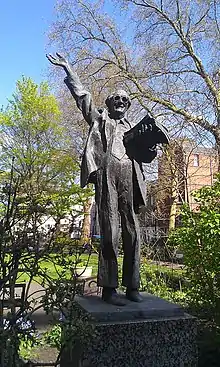Red Lion Square
Red Lion Square is a small square in Holborn, London.[1] The square was laid out in 1684 by Nicholas Barbon,[2] taking its name from the Red Lion Inn.[1] According to some sources the bodies of three regicides—Oliver Cromwell, John Bradshaw and Henry Ireton—were placed in a pit on the site of the Square.[3]


By 1720 it was a fashionable part of London: the eminent judge Bernard Hale was a resident of Red Lion Square. The square was ‘beautified’ pursuant to a 1737 Act of Parliament.[4] In the 1860s, on the other hand, it had clearly become decidedly unfashionable: the writer Anthony Trollope in his novel Orley Farm (1862) humorously reassures his readers that one of his characters is perfectly respectable, despite living in Red Lion Square. The Metropolitan Public Gardens Association's landscape gardener Fanny Wilkinson laid it out as a public garden in 1885, and, in 1894, the trustees of the square passed the freehold to the MPGA, which, in turn, passed it to the London County Council free of cost.[5]
At No. 3. in 1826 Charles Lamb was painted by Henry Mayer. At No 17. Dante Gabriel Rossetti lived in 1851. Also at No 17. William Morris, Edward Burne-Jones and Richard Watson Dixon lived from 1856 to 1859. No. 8 was a decorators shop ran by Morris, Burne Jones and others from 1860 to 1865. No. 31 was the home of F.D. Maurice[6]
The centre-piece of the garden today is a statue by Ian Walters of Fenner Brockway, which was installed in 1986. There is also a memorial bust of Bertrand Russell.[7] Conway Hall—which is the home of the South Place Ethical Society and the National Secular Society—opens on to the Square. On 15 June 1974 a meeting by the National Front in Conway Hall resulted in a protest by anti-fascist groups. The following disorder and police action left one student—Kevin Gately from the University of Warwick—dead.[8]
The square today is home to the Royal College of Anaesthetists. Lamb's Conduit Street is nearby and the nearest underground station is Holborn.
The first headquarters of Marshall, Faulkner & Co, which was founded by William Morris, was at 8 Red Lion Square.
At No 4 Parton Street, a cul-de-sac off the square subsequently obliterated by St Martin’s College of Art in Southampton Row (later Central Saint Martins), a group of young writers, including Dylan Thomas, George Barker, David Gascoyne and John Pudney gathered about the bookshop run by David Archer.[9]
References
- Notes
- Besant 2009, p. 26.
- "UCL Bloomsbury Project". www.ucl.ac.uk.
- British History Online Old and New London Volume 4, Edward Walford (1878)
- "London Gardens Trust: Red Lion Square". Retrieved 19 January 2021.
- "London Gardens Trust: Red Lion Square". Retrieved 19 January 2021.
- Guide to Literary London, George. G.Williams, B.T.Batsford Ltd. 1973
- "Bertrand Russell Memorial". Mind. 353: 320. 1980.
- "On this day 1974: Man dies in race rally clashes". BBC Online. 15 June 1974. Retrieved 4 February 2011.
- Goodall, Anna. 'Parton Street Bookshop' in Pen Pusher
- Sources
| Wikimedia Commons has media related to Red Lion Square. |